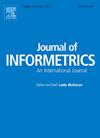干扰指数存在引文膨胀问题:重新分析CD的时间趋势以及与团队规模的关系发现差异
IF 3.5
2区 管理学
Q2 COMPUTER SCIENCE, INTERDISCIPLINARY APPLICATIONS
引用次数: 0
摘要
衡量学术界和产业界的创新率对于监测知识经济的效率和竞争力至关重要。为此,最近开发了一种中断指数(CD),并将其应用于出版物和专利引用网络(Wu 等人,2019 年;Park 等人,2023 年)。在这里,我们表明,由于研究生产的长期增长,CD 会随着时间的推移而系统性地降低,这遵循两种与创新无关的不同机制--一种是行为机制,另一种是结构机制。行为解释反映了与技术-社会因素(如自我引用实践)相关的转变,而结构解释则源于 "引文膨胀"(CI),这是由于参考文献列表长度不断增加而导致的实际引文网络不可分割的特征,它导致引文总量系统性减少。我们通过数学推导、计算模拟、多变量回归,以及对 PNAS 和 PNAS Plus 文章的破坏性进行准实验比较,证明了这一因果关系。据此,我们分析了 SciSciNet 数据库中的 CD 数据,发现干扰性在 2005-2015 年间呈递增趋势,而干扰性与团队规模之间的负相关关系在总体幅度效应大小上明显较小,当团队规模≥8 位共同作者时,这种负相关关系由负转正。本文章由计算机程序翻译,如有差异,请以英文原文为准。
The disruption index suffers from citation inflation: Re-analysis of temporal CD trend and relationship with team size reveal discrepancies
Measuring the rate of innovation in academia and industry is fundamental to monitoring the efficiency and competitiveness of the knowledge economy. To this end, a disruption index (CD) was recently developed and applied to publication and patent citation networks (Wu et al., 2019; Park et al., 2023). Here we show that CD systematically decreases over time due to secular growth in research production, following two distinct mechanisms unrelated to innovation – one behavioral and the other structural. Whereas the behavioral explanation reflects shifts associated with techno-social factors (e.g. self-citation practices), the structural explanation follows from ‘citation inflation’ (CI), an inextricable feature of real citation networks attributable to increasing reference list lengths, which causes CD to systematically decrease. We demonstrate this causal link by way of mathematical deduction, computational simulation, multi-variate regression, and quasi-experimental comparison of the disruptiveness of PNAS versus PNAS Plus articles, which differ primarily in their lengths. Accordingly, we analyze CD data available in the SciSciNet database and find that disruptiveness incrementally increased from 2005-2015, and that the negative relationship between disruption and team-size is remarkably small in overall magnitude effect size, and shifts from negative to positive for team size ≥ 8 coauthors.
求助全文
通过发布文献求助,成功后即可免费获取论文全文。
去求助
来源期刊

Journal of Informetrics
Social Sciences-Library and Information Sciences
CiteScore
6.40
自引率
16.20%
发文量
95
期刊介绍:
Journal of Informetrics (JOI) publishes rigorous high-quality research on quantitative aspects of information science. The main focus of the journal is on topics in bibliometrics, scientometrics, webometrics, patentometrics, altmetrics and research evaluation. Contributions studying informetric problems using methods from other quantitative fields, such as mathematics, statistics, computer science, economics and econometrics, and network science, are especially encouraged. JOI publishes both theoretical and empirical work. In general, case studies, for instance a bibliometric analysis focusing on a specific research field or a specific country, are not considered suitable for publication in JOI, unless they contain innovative methodological elements.
 求助内容:
求助内容: 应助结果提醒方式:
应助结果提醒方式:


